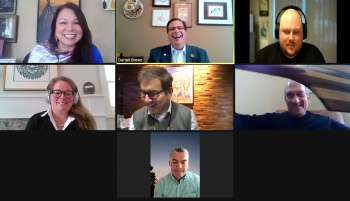Image Caption
Summary
Local Journalism Initiative Reporter
Windspeaker.com
Shannin Metatawabin was raised on the principle of not only thinking about the present but generations into the future as well.
“I think as Indigenous people we have a responsibility to our ancestors that we continue the focus of protecting the environment and ensuring there is a world here for the future yet unborn,” he said.
“My dad raised me on that. We have to plan work and that we work for those that are not yet here. And clean energy is that opportunity to put into place clean energy projects across Canada, but this has to go hand in hand with the infrastructure in our communities.”
Metatawabin, the CEO of the National Aboriginal Capital Corporation Association, spoke as part of a presentation at the Indigenous Clean Energy E-Gathering on Jan. 22.
The presentation focused on clean energy as a major economic development-driver for First Nations, Métis and Inuit communities and peoples.
“I think we can’t do anything without access to capital,” Metatawabin said. “If we wait for government, then we’ll be waiting forever. We have more than enough partners in this world and there’s more than enough capital in this world. It’s about aligning our communities to the people that want to help our community.”
Metatawabin believes Indigenous people should be taking the lead with clean energy initiatives.
Metatawabin also believes it’s key that governments are on board about changing the channel from fossil fuels.
“I think we need to give space to renewable energy because that’s our future,” he said. “As Indigenous people we owe it to our ancestors to ensure that we’re leading in this space. And if we can, bring the government along to focus more on this and to jumpstart the investment, the creation of new instruments to attract private sector capital so that we can do more and then focus on our communities.”
Chris Henderson, the executive director of Indigenous Clean Energy, said there’s another important reason to proceed with clean energy initiatives.
“I believe if we do the right thing for Indigenous clean energy—clean energy for housing, clean energy with clean fuels, clean energy with renewable energy—we will have a huge impact on the health of the country, on the health of Indigenous peoples and communities,” he said.
Henderson, a former hospital administrator, said the benefits would be tremendous to having countless clean energy initiatives brought forward.
“If we make sure we do energy efficient housing that makes sure that we don’t breathe bad air in homes, that we make sure wood stoves are of a high quality so they’re not putting ash and particulate matter inside the home, that we’re making sure we keep mold in check so that it doesn’t contaminate people and the home, then what we will do is not only improve the health of people but let’s remember the biggest single expenditure in our country is on health care,” Henderson said.
Bill Williams, the executive director of the Nunavut Economic Developers Association, believes it only makes sense who should be leading clean energy projects.
“Indigenous peoples are the original sustainable developers,” Williams said. “They never take more than they need and they develop with what’s with them and around them in the community.”
Williams said listening to Indigenous views on these issues would be prudent.
“As a non-Indigenous Canadian, and other non-Indigenous Canadians, I think we can learn way more about sustainable development from Indigenous people if we would just listen,” he said.
Dawn Madahbee Leach, the vice-chair of the National Indigenous Economic Development Board, said building capacity is the most important thing that can be done now in terms of clean energy.
Madahbee Leach also said the International Organization for Economic Co-operation and Development released a report on Indigenous economic development last year.
One of the report’s recommendations was to explore the possibility of building Indigenous centres of excellence. These facilities would lead the way in practices and research, case studies and provide communities with the proper tools to make wise decisions.
“We would have a better chance to make informed decisions, to make better partnerships, to really be leaders in this industry because we would be looking at the leading practices and Indigenous businesses involved in clean energy projects and our employees and how to manage these projects,” she said.
Madahbee Leach also believes collaboration with others would be extremely beneficial.
“We are already building this capacity, but we need to share our progress and our missteps so we can all learn to do better,” she said. “We can share our successes with our Indigenous brothers and sisters globally as well.”
Others who spoke at the presentation were Troy Jerome, the president and CEO of SEN’TI Environmental and Indigenous Services, and Hillary Thatcher, a senior director with Canada Infrastructure Bank.
Darrell Brown, the chair of the Indigenous Clean Energy Network, moderated the presentation.
Local Journalism Initiative Reporters are supported by a financial contribution made by the Government of Canada.

